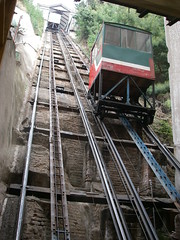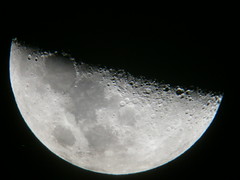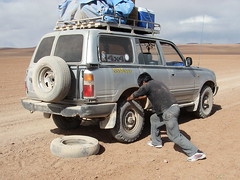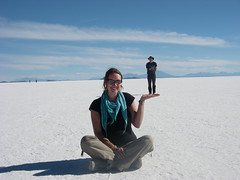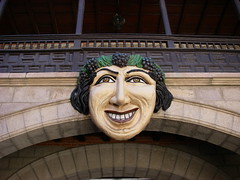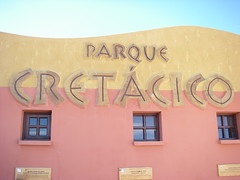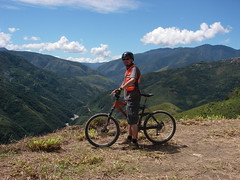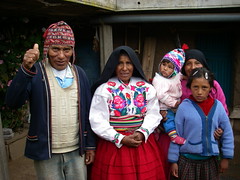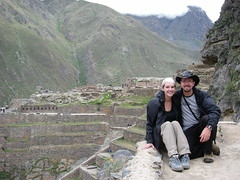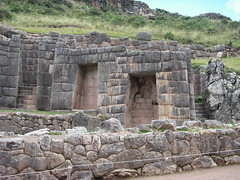We said adios to our lovely hostel owners and caught a train on Monday from Cusco to Puno. It was another Perurail affair, and wasn't too bad a journey. The rails were a bit bumpy at times and very bumpy at others but we didn't have any delays or anything and arrived in Puno on schedule at six in the evening. Peru is very sparsley populated from Cusco to Puno. We saw a few mud houses, the odd donkey, llama, pig and cow and lots of dogs. There are loads of stray dogs in Peru. Chris & I got a bit sad about it the other day when we realised it's because the children who walk around in traditional dress so that tourists can take their photos, carry puppies with them, but when they get too big they just let them go stray. Poor little fellas.
We were quite lazy when we arrived in Puno and went with one of the people who was hanging around outside the train station. The hostel that she was advertising was one that we'd thought about going to, and was quite nice and cheap, so we did okay. We also booked a Lake tour and our bus tickets to La Paz, so she did quite well out of us!
Yesterday we got up early and caught a boat with 12 other people for our two day/one night tour of Lake Titicaca. Our first stop was one of the Uros Islands - Chumi. The Uros Islands are extremely cool as they are artificial and made from the totora reeds that grow on the lake. Whilst we were there, one of the locals told us about how they make and maintain their islands by piling more layers of reeds on top when needed. Chumi was seven years old and about a metre and a half thick. The people live on about 40 different islands and they have a mayor, a school and a health centre. Usually the people make their living from fishing but the women also make things to sell to the tourists. Our guide book was quite negative about them, but we thought they were great, and that if the people didn't try to sell things then they'd be crazy. We bought a little reed boat, and also went for a ride on one.
Our next stop was Amantini Island, which was a 3 hour boat ride away. We arrived at around one o'clock and were met by some members of local families that we would be staying with. Our host was a little old lady called Isedora and we followed her up the very steep and long path to her family's house. The walk was very tiring as we were at about 3,900m.
The house was, as we were expecting, pretty basic; no electricity, running water or inside toilet. We were served some lunch and then taken up to the island's stadium. There are six separate villages on the island and they had come together for a big Easter celebration. There were brass bands from all six villages playing different music at the same time whilst the locals danced in amazingly elaborate costumes and drank beer. We sat and watched for a while and then decided to try to find the main plaza. We'd got about half way when the little girl from our family came running after us and took us back to the festivities. We didn't have enough Spanish to explain what we were doing and that we weren't lost, so we followed her back. She kept a close eye on us until it was time to go back to the house for dinner.
When the sun went down the temperature plummeted and we were very cold in our little room. We wore all our clothes and sat around our one candle playing cards. At around 9 o'clock we ventured out to the toilet and were taken aback by the beautiful sky. We could see so many stars that it was difficult to make out the constellations!
As it was so cold that our bones hurt, we decided to go to bed and get warm under the six blankets. The rain pounded down on our tin roof all night and we were awoken early by a sheep.
After breakfast we took a few photos of our family. The little girl is so beautiful, but unfortunately not used to having her photo taken. I took two polaroids and gave them one as a present before we walked back down the hill to get our boat.
The last island on our tour was Taquile, an hour's boat ride from Amantini. Like Amantini, it was a real island with hills, so we had another long walk to the main plaza. Taquile has a cooperative system in place with regards to their handicrafts. They are all sold in the same place and they take turns in manning the shop. Like on Amantini the people dress in a very traditional way. On Taquile, if you are a married man you wear a red hat, if you are single, you wear a red and white hat. Married women wear red skirts, whereas unmarried women can wear more colours.
There was a festival going on here too, so we saw some more great costumes, including a little boy in a gorilla suit. In the main plaza there were lots of children trying to sell braclets. We had brought our pencils with us so gave them out to them, for which they were very grateful. Another member of our group had brought balloons and made them all balloon animals, they loved it. It's a great idea.
On our way back down to the boat there were various stalls. The last one that we came to was manned by a cheeky little boy. Chris was trying to take a photo through an arch, but the little boy kept sneaking in and asking for a tip to take his picture. We gave him a pencil!
The boat trip back was fine, we passed the Uros Islands again and then got back into Puno as it started to hail. Tomorrow we say adios to Peru as we get our bus across the border to La Paz.

